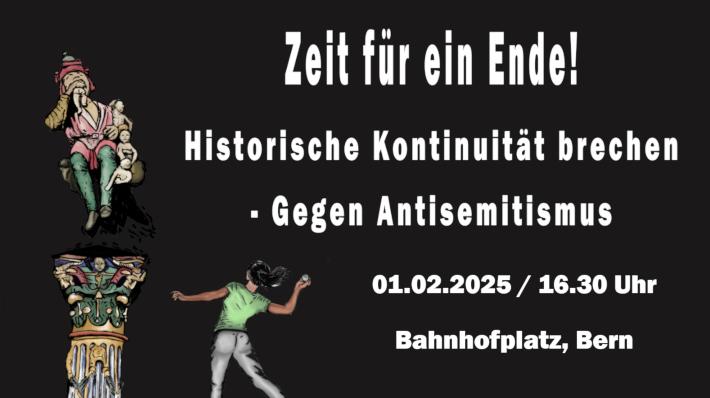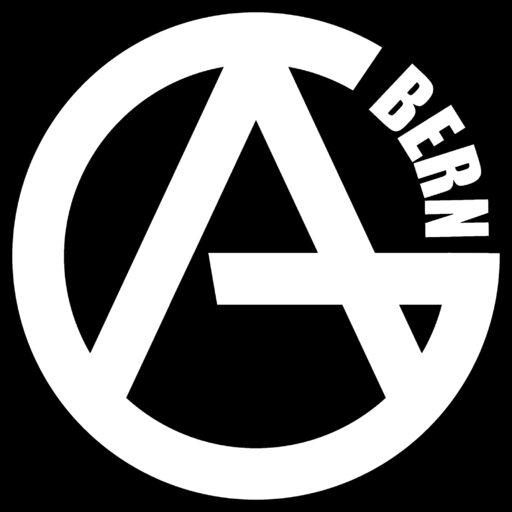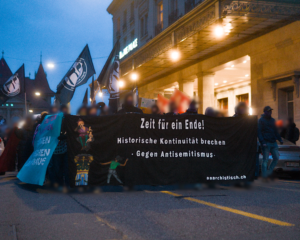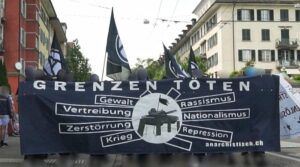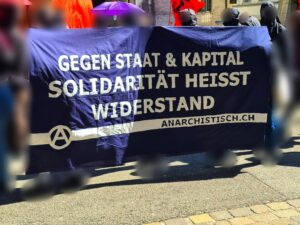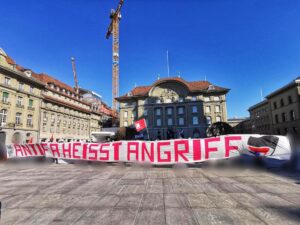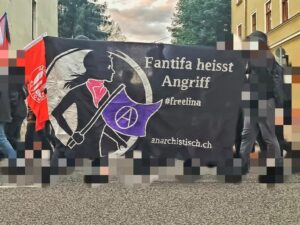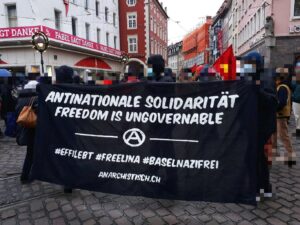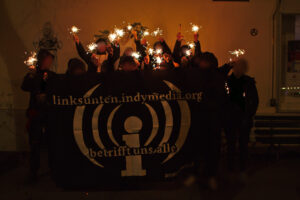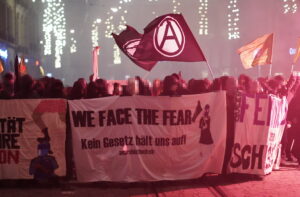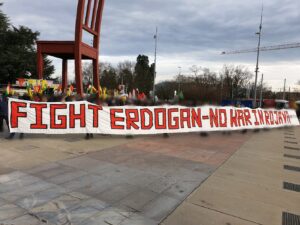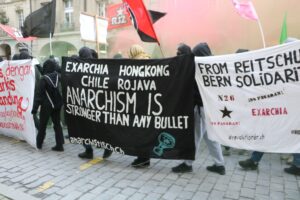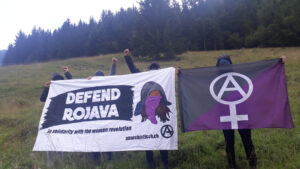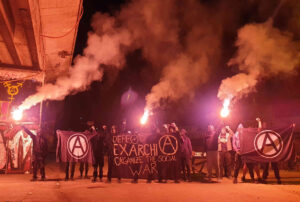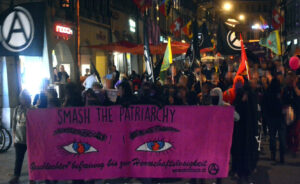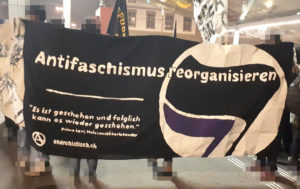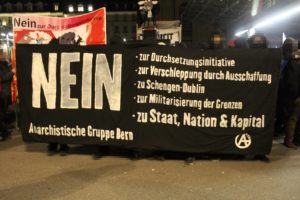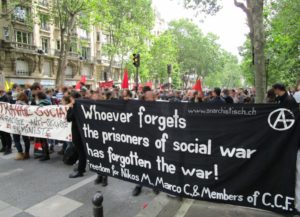2025 jährt sich zum 80. Mal die militärische Befreiung vom Konzentrationslager Auschwitz. Auschwitz steht symbolisch für ein unbeschreibliches Leid, welches durch die staatliche Vernichtungsmaschinerie des Nationalsozialismus umgesetzt wurde: für die Shoah, den jüdischen Begriff für den Holocaust, den Porajmos, den Genozid an den Sinti*zze und Rom*nja, wie auch die Massenmorde an anderen Verfolgten. 80 Jahre danach verblassen die Erinnerungen daran und die mörderische Ideologie des Faschismus erstarkt wieder.
Auschwitz war jedoch weder der Anfang noch das Ende des Antisemitismus. Bereits im Mittelalter war die jüdische Geschichte, so wie in Bern, geprägt von Pogromen aufgrund von Ritualmordvorwürfen und antisemitischen Verschwörungserzählungen. Mehrmals wurde die jüdische Bevölkerung fast vollständig vertrieben, alte historische Einrichtungen wurden zerstört oder enteignet. Während dem Zweiten Weltkrieg wurden an der schweizer Grenze jüdische Personen und auch politische Verfolgte zurückgewiesen oder im Inland verhaftet und ausgeschafft. Die Jüdin Céline Zagiel wird auf dem jüdischen Friedhof in Bern verhaftet, nach Frankreich ausgeschafft und stirbt in Auschwitz. Auch in der Schweiz wütet die tödliche Gewalt, so wird der Berner Jude Arthur Bloch von Sympathisanten des Nationalsozialismus ermordet. Unter dem Deckmantel der Neutralität füllten sich derweil die Tresore der schweizer Banken mit Gold und Wertgegenständen u.a. von enteigneten Jüdinnen und Juden. Auch in jüngerer Gegenwart ist Antisemitismus präsent. Während der Corona-Pandemie waren die sogenannte «Anti-Corona»-Demonstrationen geprägt von antisemitischen Symbolen und Parolen. Dies sind nur einige Beispiele, die zeigen, wie Antisemitismus über Jahrhunderte hinweg zu finden ist.
Antisemitismus ist seit der Entstehung des Faschismus fester Bestandteil der Ideologie. Darüber kann auch ihr vermeintlicher Kampf gegen Antisemitismus nicht täuschen. Die Antisemitismuskritik von rechts dient allzu oft der Propaganda des eigenen antimuslimischen Rassismus.
Von Umfragen, über Recherchen bis hin zu Anschlägen wie in Halle zeigt sich klar, dass die grösste Bedrohung weiterhin von rechts kommt. Klar ist aber auch, dass Antisemitismus in allen Bereichen in der Gesellschaft zu finden ist und somit auch überall thematisiert, sowie bekämpft werden muss. Das bedeutet, dass auch in unseren Kreisen eine Auseinandersetzung mit Antisemitismus stattfinden muss, welche verschiedene Unterdrückungsformen nicht gegeneinander ausspielt, sondern verbindet. Deswegen unterstützen wir das Bündnis «Erinnern heisst Leben – gegen Antisemitismus», welche aktuell eine Veranstaltungsreihe zwischen der Reichspogromnacht und dem 80. Jahrestag der Auschwitzbefreiung zu den verschiedenen Aspekten der historischen Entwicklung des Antisemitismus organisiert.
Gehen wir am 01. Februar auf die Strasse. Es ist Zeit für ein Ende! Brechen wir die historische Kontinuität des Antisemitismus
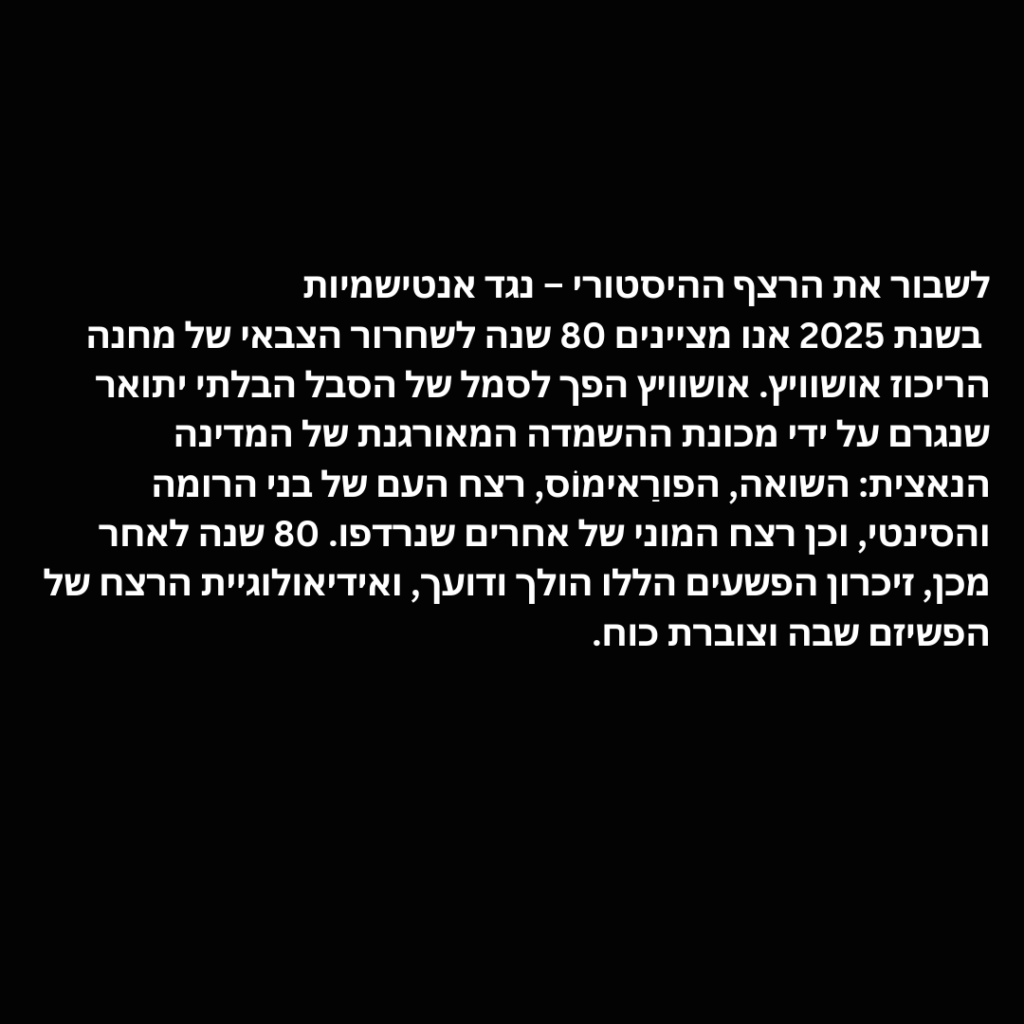
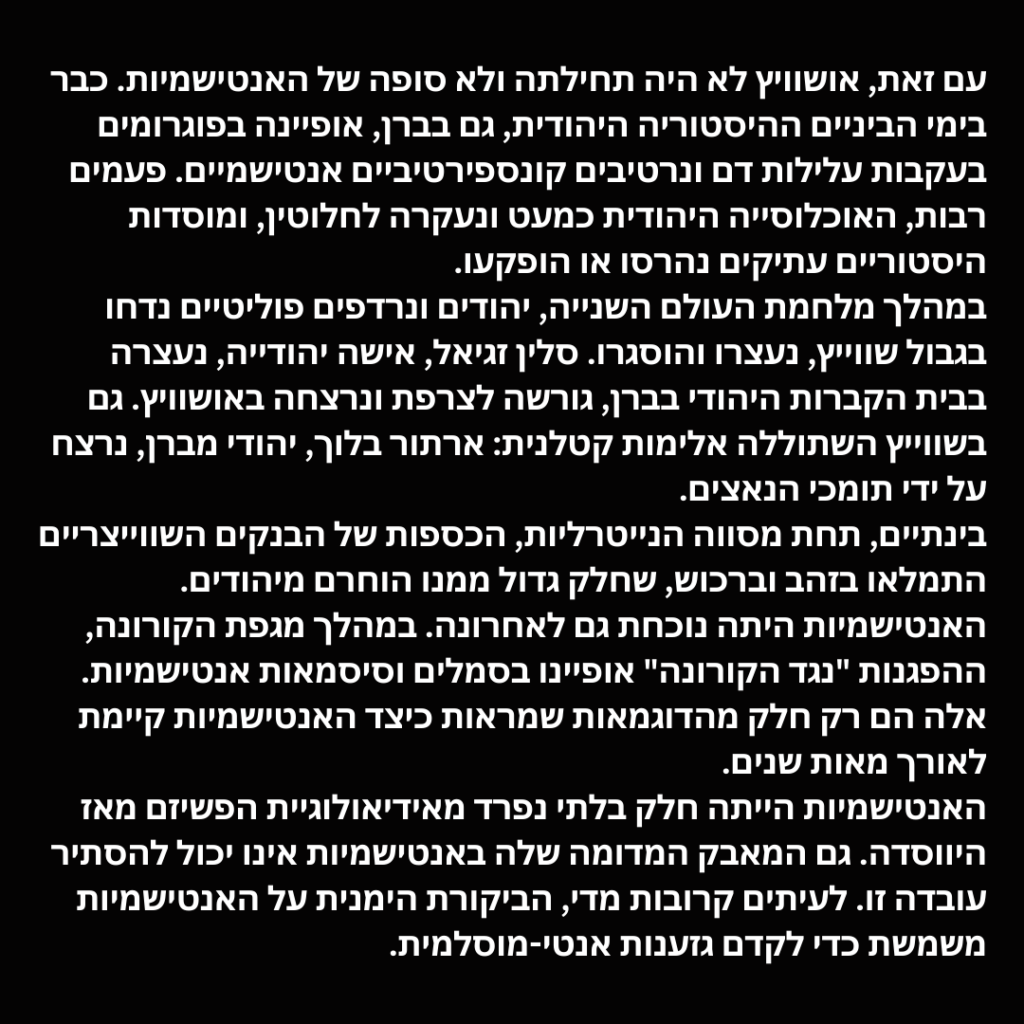
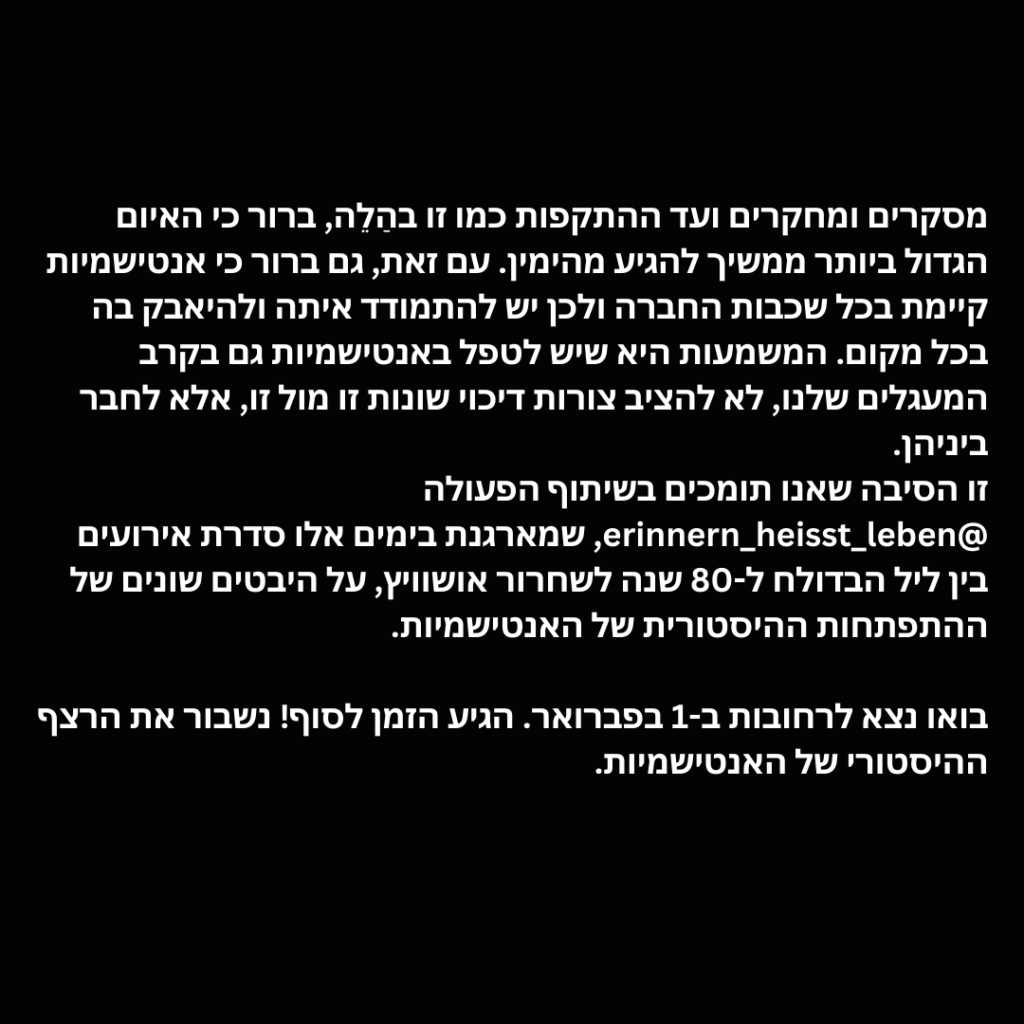
Break the historical cycle – against antisemitism
2025 marks the 80th anniversary of the military liberation of the Auschwitz concentration camp. Auschwitz is a symbol of the unspeakable suffering inflicted by the National Socialist state-organised machinery of annihilation: the Shoah, the Jewish term for the Holocaust, the Porajmos, the genocide of the Sinti and Roma as well as the mass murders of others who were persecuted. 80 years later, memories of these crimes are fading and the murderous ideology of fascism is once again gaining strength.
However, Auschwitz was neither the beginning nor the end of antisemitism. As early as the Middle Ages Jewish history, also in Bern, was marked by pogroms due to accusations of ritual murder and antisemitic conspiracy narratives. On several occasions, the Jewish population was almost completely expelled, and old historical institutions were destroyed or expropriated. During the Second World War, Jewish people and political persecutees were rejected at the Swiss border or arrested in Switzerland and deported. Céline Zagiel, a Jewish woman, was arrested at the Jewish cemetery in Bern, deported to France and died in Auschwitz. Deadly violence also raged in Switzerland : the Bernese Jew Arthur Bloch was murdered by Nazi sympathisers. Meanwhile, under the guise of neutrality, the vaults of Swiss banks were filling up with gold and valuables, much of it had been seized from expropriated Jews. Antisemitism has also been present in more recent times. During the coronavirus pandemic, the so-called ‘anti-coronavirus’ demonstrations were characterised by antisemitic symbols and slogans. These are just a few examples that show how antisemitism has existed for centuries.
Antisemitism has been an integral part of fascist ideology since its inception. Even its supposed fight against antisemitism cannot hide this fact. All too often, criticism of antisemitism from the right is used to propagate its own anti-Muslim racism.
From surveys and research to attacks like the one in Halle, it is clear that the greatest threat continues to come from the right. However, it is also clear that antisemitism can be found in all areas of the society and must therefore be addressed and fought everywhere. This means that antisemitism must also be addressed in our circles, not playing off different forms of oppression against each other, but connecting them. That is why we support the „Erinnern heisst Leben“ alliance, which is currently organising a series of events between the Reichspogromnacht and the 80th anniversary of the liberation of Auschwitz on the various aspects of the historical development of antisemitism.
Let’s take to the streets on February 1st. It’s time to put an end to it! Let’s break the historical cycle of antisemitism.
Briser la continuité historique – contre l’antisémitisme
2025 marquera le 80e anniversaire de la libération militaire du camp de concentration d’Auschwitz. Auschwitz est le symbole d’une souffrance indescriptible mise en œuvre par la machine d’extermination étatique du national-socialisme : la Shoah, terme juif désignant l’Holocauste, le Porajmos, le génocide des sinté.e.s et des rom.e.s, ainsi que les meurtres de masse d’autres personnes persécutées. Quatre-vingts ans plus tard, les souvenirs s’estompent et l’idéologie meurtrière du fascisme se renforce à nouveau.
Auschwitz n’était pourtant ni le début ni la fin de l’antisémitisme. Au Moyen-Âge déjà, l’histoire juive était marquée, comme à Berne, par des pogroms dus à des accusations de meurtres rituels et à des récits de conspiration antisémites. A plusieurs reprises, la population juive a été presque entièrement expulsée, d’anciennes institutions historiques ont été détruites ou expropriées. Pendant la Seconde Guerre mondiale, des personnes juives ainsi que des persécuté.e.s politiques ont été refoulés à la frontière suisse ou arrêtés et expulsés à l’intérieur du pays. La juive Céline Zagiel est arrêtée dans le cimetière juif de Berne, expulsée vers la France et meurt à Auschwitz. La violence meurtrière fait également rage en Suisse, le juif bernois Arthur Bloch est ainsi assassiné par des sympathisants du national-socialisme. Pendant ce temps, sous le couvert de la neutralité, les coffres-forts des banques suisses se remplissent d’or et d’objets de valeur, entre autres de juif.ve.s exproprié.e.s. L’antisémitisme est également présent dans un passé plus récent. Pendant la pandémie de Corona, les manifestations dites « anti-Corona » étaient marquées par des symboles et des slogans antisémites. Ce ne sont que quelques exemples qui montrent comment l’antisémitisme se manifeste au fil des siècles.
L’antisémitisme fait partie intégrante de l’idéologie du fascisme depuis sa naissance. Leur prétendue lutte contre l’antisémitisme ne peut pas non plus faire illusion à ce sujet. La critique de l’antisémitisme par la droite sert trop souvent à la propagande de son propre racisme antimusulman.
Les sondages, les recherches et les attentats comme celui de Halle montrent que la plus grande menace vient toujours de la droite. Mais il est également clair que l’antisémitisme est présent dans tous les sphères de la société et qu’il doit donc être thématisé et combattu partout. Cela signifie que dans nos cercles aussi, une discussion sur l’antisémitisme doit avoir lieu, qui n’oppose pas les différentes formes d’oppression mais les relie. C’est pourquoi nous soutenons l’alliance „Erinnern Heisst Leben“, qui organise actuellement une série d’évènements entre la Reichspogromnacht et le 80e anniversaire de la libération d’Auschwitz sur les différents aspects du développement historique de l’antisémitisme.
Descendons dans la rue le 1er février. Il est temps de mettre fin à l’antisémitisme ! Brisons sa continuité historique !

